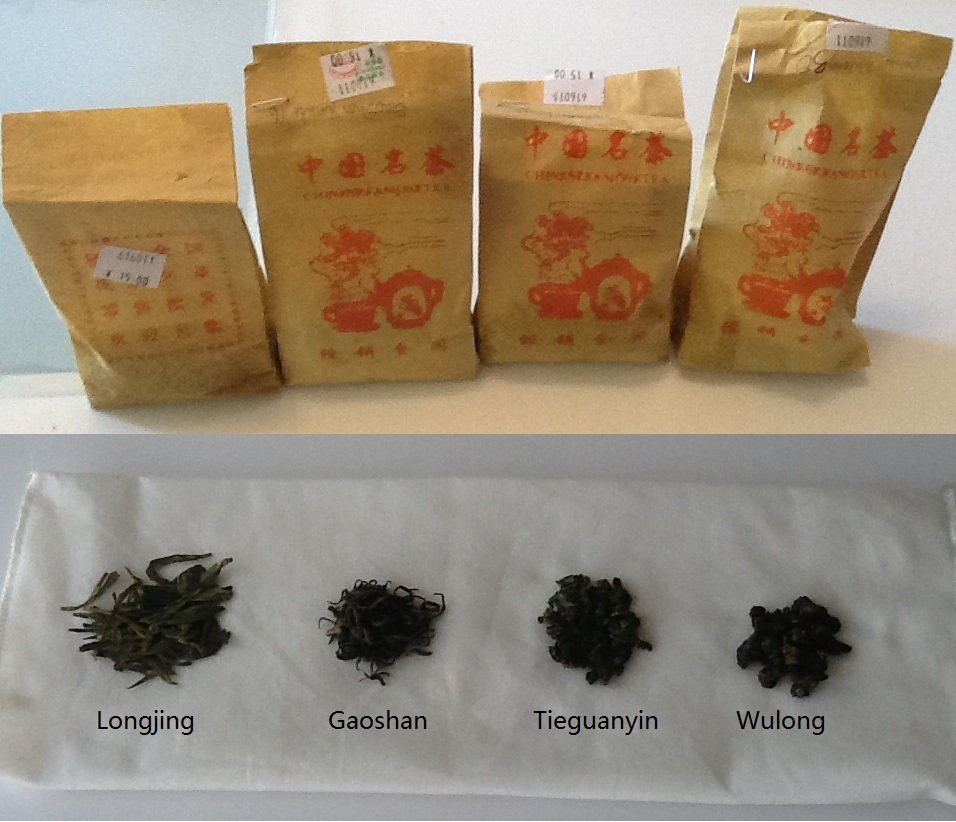For those who are just getting aquianted with East Asian tea varieties, I suggest visiting a previous article I wrote called “Understanding the World of Tea” that describes the main differences between a large range of teas and how they are produced. Today we are going to discuss a few specific types of Green Tea that seem quite similar to the naked eye. (Click the images to zoom in)
Although there are more types in circulation, our candidates for today’s Great Tea comparison include Longjing, Gaoshan Yunwu, Tieguanyin, and Wulong. At first glance, the Longjing tea leaves are flatter and look more like refined pine leaves. The Gaoshan tea leaves are thinner and a little curled. Tieguanyin and Wulong both appear to be buds of scrunched up leaves.
Pricing: The Tieguanyin used in this comparison was bought at a medium price-range, about $23 per 500 grams. The Wulong I used here cost around $45 per 500g, so you can expect a difference in quality between these samples. The Longjing and Gaoshan were both around $20 per 500g.
TIP! For the most part, the fatter the buds (or nuggets) the better the tea. Why? Because they contain fatter leaves which is better than chopped or ripped up leaves.
Brew Time: I brewed each type for about 2-3 minutes so that they could unravel. Remember that this way of brewing tea requires multiple occassions of steeping; meaning that you can pour new water into these leaves a few times before they get used up or lose taste. The top left is Longjing which gave a light and planty taste after steeping once. The Gaoshan tea is in the top right which gave a stronger and earthier flaver. The bottom left, with those plump leaves, was the less expensive Tieguanyin and it gave what I call a light and buttery taste. Finally, the more expensive Wulong on the bottom right gave a similar but less sweet flavor than the Tieguanyin.
Why would a more expensive green tea give off less flavor? Well, actually, it is meant to be steeped multiple times and unravel more slowly. By using a tea that opens slowly it can be used for a longer time. So, I wouldn’t count out the Wulong as being a poor value in this comparison.
The leaves leftover: The pictures below show the resulting open leaves after steeping Longjing and Gaoshan, as well as Tieguanyin and Wulong. You can see the differences much more clearly after steeping these leaves.
Which one is better? Well, I’d be lying if I suggested avoiding any of them! When I want something light I’ll probably go with a Longjing. If I want something stronger, I might go for Wulong. But now that I’ve compared all of these, I would probably go for an average-priced Tieguanyin because it jumped out at me today with a nice buttery flavor on the first steeping. I suggest trying even more types and comparing them for yourself. Perhaps I’ll compare even more and post them on Asianliving.me for your drinking pleasure!
By the way, if you are more of a coffee drinker and could never see yourself drinking much of these kinds of tea, why not try Pu’er tea? It steeps very dark and has a strong earthy taste.




 Custom Search
Custom Search